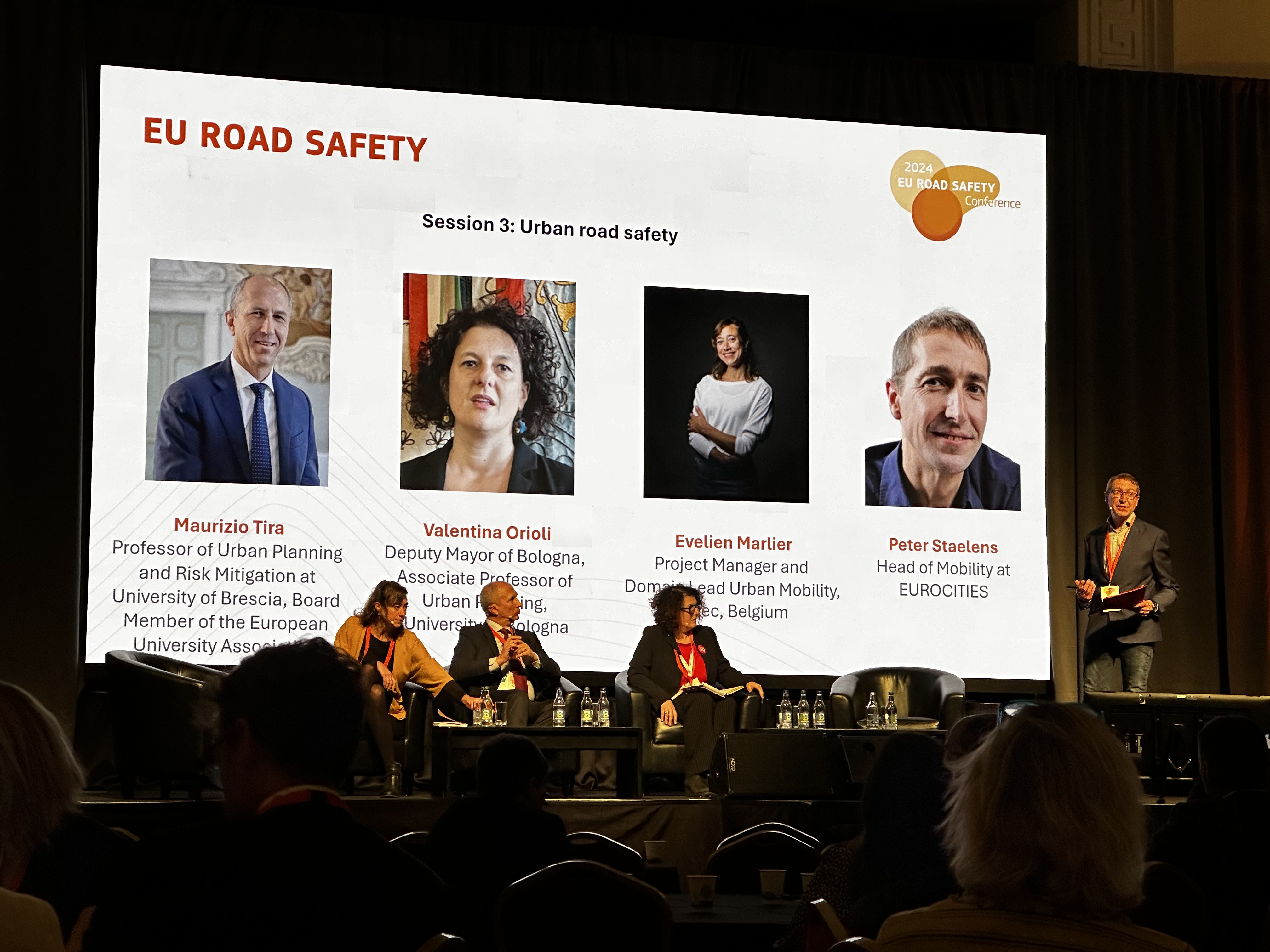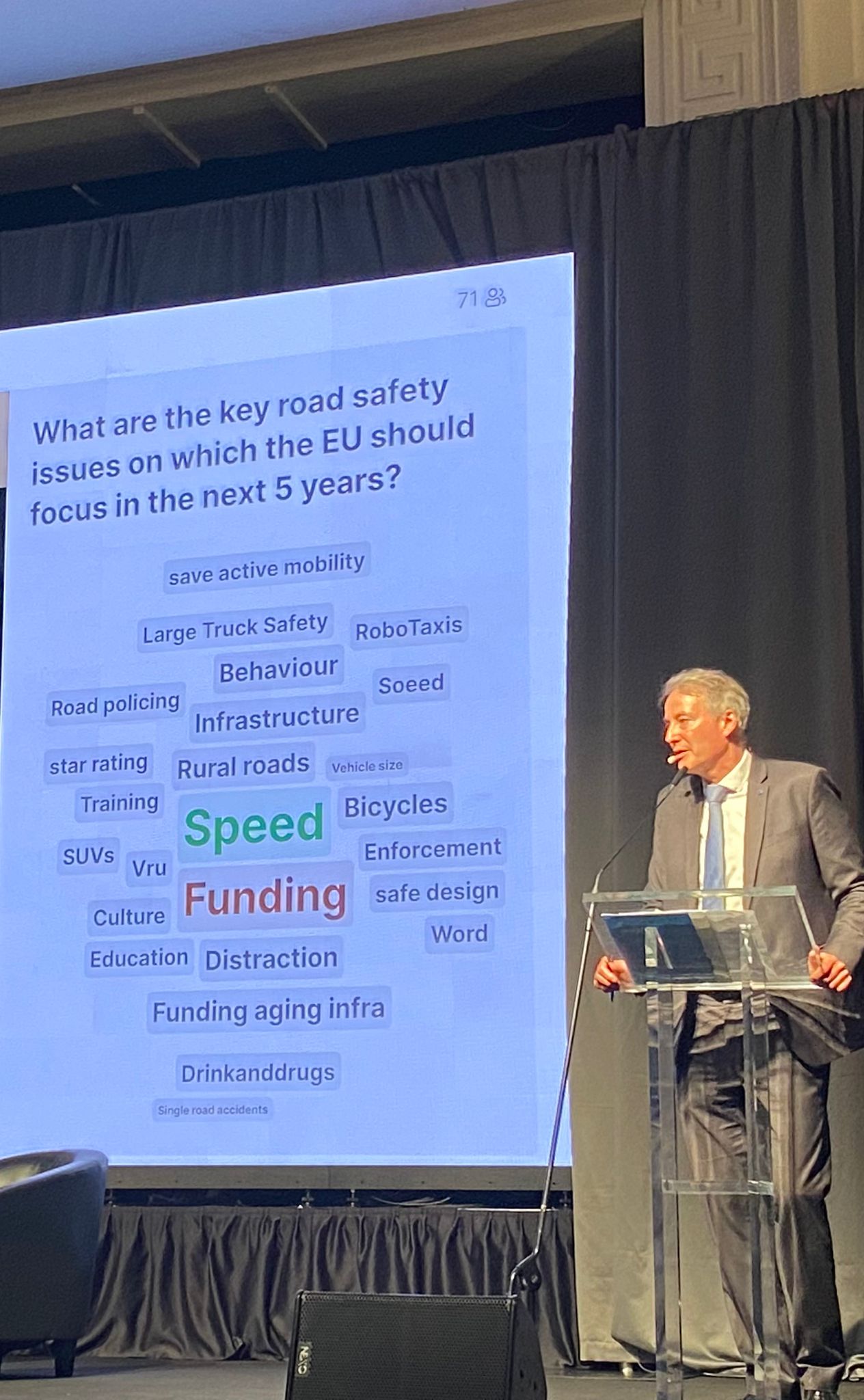On the 16th of April road safety experts and authorities came together in Dublin at the EU Road Safety Conference of the European Commission to discuss the progress made so far with implementing the Safe System approach and with achieving the goals of halving road deaths by 2030. The conference was opened by Director-General Magda Kopczyńska and moderated by Director Kristian Schmidt of DG MOVE.

“Road safety is an emergency but nobody treats it as one.”
The conference commenced with a panel discussion on progress towards the 2030 target, featuring Jack Chambers (Minister of State for Transport, Ireland), Georges Gilkinet (Minister of Transport, Belgium), Shailen Bhatt (Administrator, US Federal Highways Administration), and moderator Magda Kopczynska (Director General DG MOVE). Unfortunately, Ireland is driving off course after previously being on track for the 2030 milestone. Their strategy now focuses on preventing dangerous behaviour through the introduction of additional speed limits, new drug testing methods, increased research, and enhanced camera-based enforcement.
In the United States, the road death toll rose significantly from 32,367 in 2011 to 40,990 in 2023, highlighting a concerning trend. Three primary challenges were identified:
- Rural challenges (e.g. post-crash care)
- Urban challenges (e.g. speed)
- Sub-urban (e.g. infrastructure for heavy vehicles)
All speakers emphasized the pervasive acceptance of dangerous behaviours like speeding and driving under the influence of alcohol and/or drugs in modern society. They stressed the importance of integrating road safety into discussions on drugs and alcohol, When discussing the legalization of drugs, the impact on road safety needs to be discussed as well.

“Humans make mistakes, but is should never become a deathly mistake.”
The first thematic session featured George Yannis (NTUA), Sofia Gjestad (Swedish Transport Administration), Alvaro Gomez (Directorate General for Traffic), and moderator Jonathon Passmore (WHO Regional Office for Europe), who delved into the implementation of the safe system approach. The quote of Jonathon Passmore illustrates perfectly the key message behind the safe system approach. Yet the use of it is still failing since every 26 seconds someone dies on the road worldwide. The session highlighted three crucial takeaways:
- The safe system approach should be developed for each target audience separately;
- Countries are struggling with an aging population and vehicles;
- KPI monitoring is essential to measure the impact of the safe system approach.
But a key question was asked: should we not take into account also other types of KPIs, such as the percentage of people afraid to cycle?
“Mobility is a system that needs to be safe”
Maria Tsavachidis (EIT urban mobility), Laurianne Krid (FIA), Michiel Christoph (SWOV), along with moderator Geertje Hegeman (Ministry of Infrastructure and Water Management Netherlands), discussed how automated vehicles could reshape road safety in the future and the challenges they pose. While automated vehicles are still in the "almost ready" phase, the timeline for their next step remains uncertain. Nonetheless, there's a pressing need for the automotive industry to pivot from prioritizing driver comfort to integrating a maximum number of safety features. As technology takes over more driving responsibilities, there's a risk of either confusing or disengaging drivers. Hence, it's imperative that drivers receive comprehensive information about their vehicle, advanced driver-assistance systems (ADAS), and their roles as drivers, rather than discovering these aspects through trial and error. One key insight from the MEDIATOR project (MEDiating between Driver and Intelligent Automated Transport systems on Our Roads) was that driver-influencing features such as seats, mirrors, and steering wheels should adapt based on the expected driving tasks.
“Vulnerable road users are not vulnerable, they are valuable.”
The urban mobility session, featuring Maurizio Tira (University of Brescia & ETSC), Valentina Orioli (City of Bologna), Evelien Marlier (IMEC), and moderator Peter Staelens (Eurocities), explored strategies for enhancing road safety within cities. Urban mobility presents a multifaceted challenge, with diverse road users each facing unique needs and obstacles. While a 30km/h speed limit for cars in certain zones have shown to be impactful, cities encounter difficulties in the implementation often due to conflicts with citizens and federal governments. Hence, citizen engagement must be prioritized, involving activities like panel discussions, appointing local ambassadors, and crafting tailored campaigns. Empowering citizens to initiate their own local road safety projects with funding enables them to effect positive change. During all these actions, particular attention should be paid to addressing digital poverty and the challenges of road users with limited mobility.
Following the discussion on urban road safety, attention turned to the equally critical issue of rural road transport. Heli Siirilä (Vaasa University), Veronika Valentova (Transport Research Centre), Uroš Brumec (Slovenian Infrastructure Agency), and moderator Véronique Feypell (ITF-OECD) identified key challenges, including:
- Inadequate infrastructure for Advanced Driver Assistance Systems (ADAS)
- Non-intuitive roads and curves
- Challenges associated with overtaking on long road
- Complex junctions
Rural roads are essential for economic and social life in rural areas. But they are the most dangerous location for fatal road crashes, with 53% of all EU road deaths taking place on rural roads. Giovanni Pintor, representing the road safety association “Adesso Basta,” provided a compelling testimony underscoring the necessity of investing in improving rural roads despite the challenges they present.

“It was the car that was written off, not me. But my life changed that day.”
The last session on post-crash care was opened by a second testimony, this time given by road crash survivor Méabh White. Mark Broughton (Johanniter International), Katarzyna Dobrzanska-Junco (Road Safety Council Malopolskie) and Dr Ruairi Connolly (Cork University Hospital).
Road crashes not only result in the deaths of over 20.000 people a year in the EU, they also cause life-changing injuries to 5 to 6 times that number. These crashes often result in polytraumas due to the involvement of multiple types of injuries, leading to extended recovery periods. Challenges persist in accurately documenting crash information, reducing response times, and providing psychological rehabilitation for survivors. Implementing structured social support systems for victims, offering first-aid training to all drivers, and leveraging technology in hospitals can enhance rehabilitation efforts.
The conference was closed by Kristian Schmidt who asked the audience to highlight the key issues that the Commission should focus on in the next five years. Many suggestions were made and it was concluded that speed and funding should be the two main focus points.

Geographical coverage
